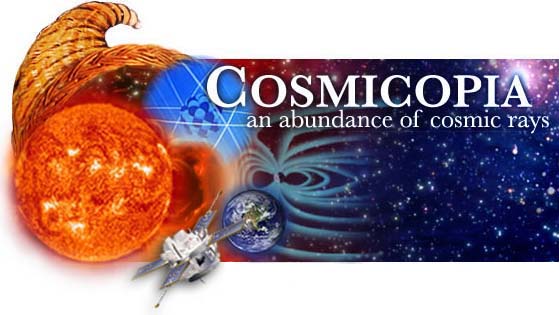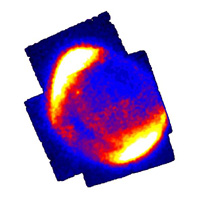
Composition
The Particle Adventure (by the Particle Data Group) introduces the theory of fundamental particles and forces, called the Standard Model. It explores the experimental evidence and the reasons physicists want to go beyond this theory. In addition, it provides information on particle decay and a brief history section.
The Science of Matter, Space, and Time (by the Fermilab) contains another good particle physics "tour".
New elements are created in stars by a process called nucleosynthesis. (More about nucleosynthesis...)
The number of neutrons tells us which isotope of the element is present. The isotope number is the total of the number of protons plus the neutrons. Take carbon, for example, which is a very common element necessary for life, and is found in nature as diamonds and graphite. We find several different isotopes of carbon in nature. Carbon-12 has an equal number of protons and neutrons, six of each. Carbon-14 contains two more neutrons (eight) than carbon-12, but still has only six protons. This makes carbon-14 an isotope of carbon, but it is different from carbon-12. While carbon-12 is a stable isotope, carbon-14 is unstable, or radioactive. It is much less common in nature but is found where carbon-12 is found. Because of its radioactive nature, carbon-14 is used to date archaeological artifacts. Shown in this figure, deuterium and tritium are isotopes of hydrogen. This image is from the Princeton Plasma Physics Laboratory, which also offers a good interactive tour of matter.
The periodic table of the elements provides some information about each of the different elements. Each element has distinctive properties, and those with similar properties are grouped into families, shown by the different colors. Follow the link on the periodic table here to learn more about it and the different elements.
In an atom, the number of electrons that orbit the nucleus equals the number of protons in the nucleus, thus making an atom electrically neutral. When bombarded by ultraviolet (UV) radiation or after being struck by energetic particles, atoms can lose one or more of their electrons. The positively charged remains of these atoms are called ions. The number of electrons lost determines the charge state of the particle. For example, alpha particles are helium nuclei with a double positive charge; they have two protons and two neutrons, but no electrons.
Together with their freed electrons, the ions form a plasma. Plasma is a fourth state of matter, not a liquid, solid, or gas. Matter in the Sun is in a plasma state. Plasma is the most common state of matter in the Universe. More than 99% of all matter is plasma, so what we see on Earth is the exception. Since plasmas consist of electrically-charged particles, electric and magnetic forces affect a plasma.
When we measure the elemental, isotopic, and charge composition of ions, it helps us to understand how nature selected the particles and accelerated them to the energies at which we find them. The "composition" of electrons is not interesting, since all electrons look the same. But their number, energy, and direction of travel are important.
 Composition in the News:
Composition in the News:
August 10, 2009: Exploring the standard model of physics without the high-energy collider -- Eurekalert
August 6, 2009: New experiment could reveal make-up of the universe -- Eurekalert
July 24, 2009: Ray of hope in dark-matter hunt -- Nature
July 14, 2009: 'Copernicium' proposed as name for newly discovered element 112 -- Eurekalert
July 13, 2009: Dark matter helped early galaxies survive "massacre" -- National Geographic
July 8, 2009: Astrophysicists solve mystery in Milky Way galaxy -- UCSD
July 1, 2009: Mass mismatch makes mystery for proton's strange cousin -- Science News
June 30, 2009: Solar ghosts may haunt Earth's radioactive atoms -- New Scientist
June 29, 2009: NuTeV anomaly helps shed light on physics of the nucleus -- Science Daily
June 26, 2009: Magnetic 'superatoms' promise tuneable materials -- New Scientist
June 19, 2009: Quirky supernova could be something new -- New Scientist
June 19, 2009: A Higgs boson without the mess -- Physical Review Focus
June 15, 2009: First new element for five years makes periodic table -- New Scientist
June 15, 2009: Magnetic super-atoms discovered -- Science Daily
May 29, 2009: Dark-energy particle spotted? -- Nature
May 28, 2009: Great moments in GRIStory -- NASA
May 28, 2009: Particle physics -- it matters, say UK policy makers -- Physics World
April 14, 2009: 13 things that do not make sense (#5 Dark matter, #7 Tetraneutrons) -- New Scientist
March 31, 2009: Spooky mirror tricks -- Max Planck Institute
March 29, 2009: Signals of a strange universe -- APOD
March 23, 2009: SPICE will measure Sun's plasma properties -- Astronomy.com
March 18, 2009: Particle oddball surprises CDF physicists at Fermilab -- Fermilab
March 13, 2009: Lasers provide antimatter bonanza -- Physical Review Focus
March 9, 2009: Fermilab collider experiments discover rare single top quark -- Fermilab
February 20, 2009: Dark matter as a source of antiparticles -- APS Physics
February 10, 2009: Chameleon particle blends into the background -- Physics World
February 9, 2009: New forces in the dark sector -- APS Physics
February 5, 2009: PAMELA paper dampens dark-matter claim -- Physics World
February 4, 2009: High pressure yields novel single-element boron 'compound' -- Science Daily
January 31, 2009: Simeis 147: Supernova remnant -- APOD
January 15, 2009: Does dark matter encircle Earth? -- Scientific American
January 7, 2009: European boost for particle therapy -- Nature
Composition Activities
Grades 5 - 12: Modeling the Periodic Table -- Genesis mission
Grades 9 - 12: Composition of Matter, Atomic Structure -- NASA GSFC
Grades 9 - 12: Cosmic Chemistry: An Elemental Question -- Genesis mission
Grades 9 - 12: From a Different Angle - World history related to the periodic table -- Genesis mission






Questions and comments to: cosmicopia@cosmicra.gsfc.nasa.gov
Curator: Beth Barbier, SP Systems
Responsible NASA Official: Dr. Tycho von Rosenvinge
Privacy Policy and Important Notices

HOME
In the News
History
Ask Us
Great Links
Glossary
Site Map
Search NASA